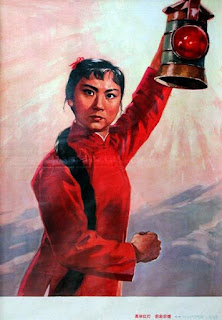The Weight of Loss
“Hold aloft the red lantern.” –Chinese poster,
1971, artist unknown.
This is a propaganda poster of Chinese
origin. When translated it reads as: “hold aloft the red lantern.” If
understood explicitly, it is most likely a reference to a female fighting group,
formed during the Boxer Uprising of the 1900s, called the Red Lanterns.
However, it could stand for other ideas too. One of them being the illuminating
effect of communism. That this dream, this ideology, is able to help one feel
the heaviness of all that has been lost. With this, it also tells a story of
what this realization leads to and most importantly, who it is felt by.
Learning about a cause leads to the
unveiling of an ability. In his memoir, Chains to Lose, Dada Amir
Haider Khan on many occasions refers to his experience in the Soviet Union as
one that led to “fundamental changes” in him. It is interesting to note how,
these changes accumulate slowly and from the very beginning of his journey. It
starts from him being given a soft bed to sleep on in the train. Eventually,
leading up to him having the chance to speak up in “exclusive” communist
meetings and circles. With this there is also a gradual growth in his
intellectual “maturity”. He talks about his urge to return to India after his
education. In many ways, one could interpret this as his acknowledgement of loss.
Going back to a place that has given him nothing but adversity, suggests a need;
a yearning to claim a part of himself he never knew how to confront before. The
knowledge of social structures and oppressed peoples helps him see his native
land as a “slave nation”. In other words, he is finally ready to look his
country in the eye, holding his fist tight to brace the unknown.
The realization of a particular self,
however, can produce a feeling of uniqueness. To understand this better, it is
helpful to acknowledge that the poster also shows a woman. This is its most
striking element. In his recollections, Dada Amir describes women as well. The
most prominent one is his Indian comrade, Suhashini, who becomes a great help, particularly
in his scholarly efforts, such as while writing his thesis. There is also a
reference to the women of the nursing school as cures for “mental fatigue”.
There is a parallel here, in that, women are a crutch. They have not been
painted as people looking for a different future. They are not described in themselves
alone, but in relation to something else. Perhaps this struggle, and this
sacrifice of one’s life for a bigger purpose leads to an inwardness. A feeling that
it is only one’s own pain that makes the revolution relevant. The poster says
otherwise. It says that others, including women have something to reveal as
well. They too have something to share in their “folk songs” and “stories”.
They too are holding up lanterns to light up their ideas and recommendations. The
individuals of the Indo-American group themselves when engaged in “quarrels”, were
indicative of the friction that can exist between two hopes stemming from the
same dream. To reconcile them under one banner is the real challenge. Unity is
easy to proclaim when the “toiling” masses are seen as nothing more than a mere
mass.
Communist Internationalism then is a
concept made up of many pieces. It is not simply the coming together of
different nationalities, but of vastly different humans, who believe their
losses can be weighed with knowledge. The weight of their grievances can vary,
but this is not a reason to raise one over another. In the end, everyone has
their own lantern, and their own destination to reach. The source of the light
however, is the same. It is this fact of being both alike and unalike that
proves to be the most difficult lesson. To come together as one subjugated community
means to understand pain in its many forms.

Comments